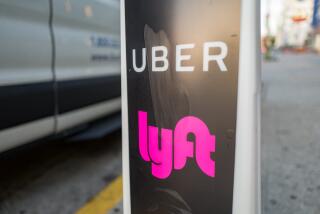Lyft says it won’t be profitable until 2021, disappointing investors

- Share via
Lyft Inc. quarterly results and guidance for 2020 disappointed investors who punished the ride-hailing company for not promising profits sooner. The shares dropped almost 4% in extended trading.
Lyft’s results come a few days after larger rival Uber Technologies Inc. reported quarterly numbers that blew past analysts’ expectations and announced that it was moving up its target for profitability. The news sent Uber’s stock price soaring.
Lyft didn’t provide updated guidance on turning a profit. Late last year, the company said it would be profitable on an adjusted basis by the fourth quarter of 2021. The stock slipped to as low as $51.06 in extended trading, after closing at $53.94 earlier in New York. Lyft’s rally of more than 25% this year — along with Uber’s recent results — raised the bar for Tuesday’s report.
While Lyft is Uber’s chief competitor, the two businesses are different. Lyft doesn’t operate outside of North America, and doesn’t deliver food or experiment with new ventures like helicopter rides or matching job candidates with short-term work.
Lyft said revenue for the three months ending Dec. 31 jumped 52% to $1.02 billion from the same period a year ago. Analysts had expected revenue of $985.8 million. The company shrunk its adjusted net loss, which excludes stock-based compensation, acquisition expenses and other costs, to $121.4 million during the fourth quarter, compared to $238.5 million for the same period a year ago. Analysts had expected an adjusted loss of $161.9 million, according to data compiled by Bloomberg.
“In 2020 we expect strong top line growth as well as important progress on our path to profitability,” Lyft Chief Financial Officer Brian Roberts said in an interview on Tuesday.
Unlike Uber, Lyft has focused solely on mobility, a category that includes ride-hailing, electric bikes, scooters and integration with public transit. The company’s strategy has been to move further into existing markets to capture more active riders and increase how much they spend on Lyft services. In recent months, the company has added public transit options to its app, introduced monthly subscriptions and offered an option to decrease ride costs by scheduling pickup a few blocks away.
The company increased its number of active riders 23% to 22.9 million, slightly outpacing analysts’ estimates of 22.8 million for the quarter. Revenue from each active rider increased 23% to $44.40 during the fourth quarter, again slightly beating analysts’ estimate of $43.16.
Like Uber, Lyft is trying to focus on profitable growth by curtailing the discounts and incentives it initially used to hook new riders and drivers. The San Francisco-based company has also sought to trim costs. Last month it said it would cut 90 jobs as part of a larger restructuring effort.
For 2020, Lyft said it expects to generate between $4.58 billion and $4.65 billion in revenue and projected that it will narrow its losses before interest, taxes and other expenses to between $450 million and $490 million, from $678.9 million in 2019.
Some analysts have flagged a new California law reclassifying many gig economy workers as employees as a risk for Lyft, Uber and others, potentially triggering price hikes estimated to be as high as 30%. Roberts waved off concerns about the law’s impact, saying Lyft was “100% focused” on putting an alternative measure on the November ballot and has already helped collect 325,000 of the 500,000 signatures required by May to qualify.





